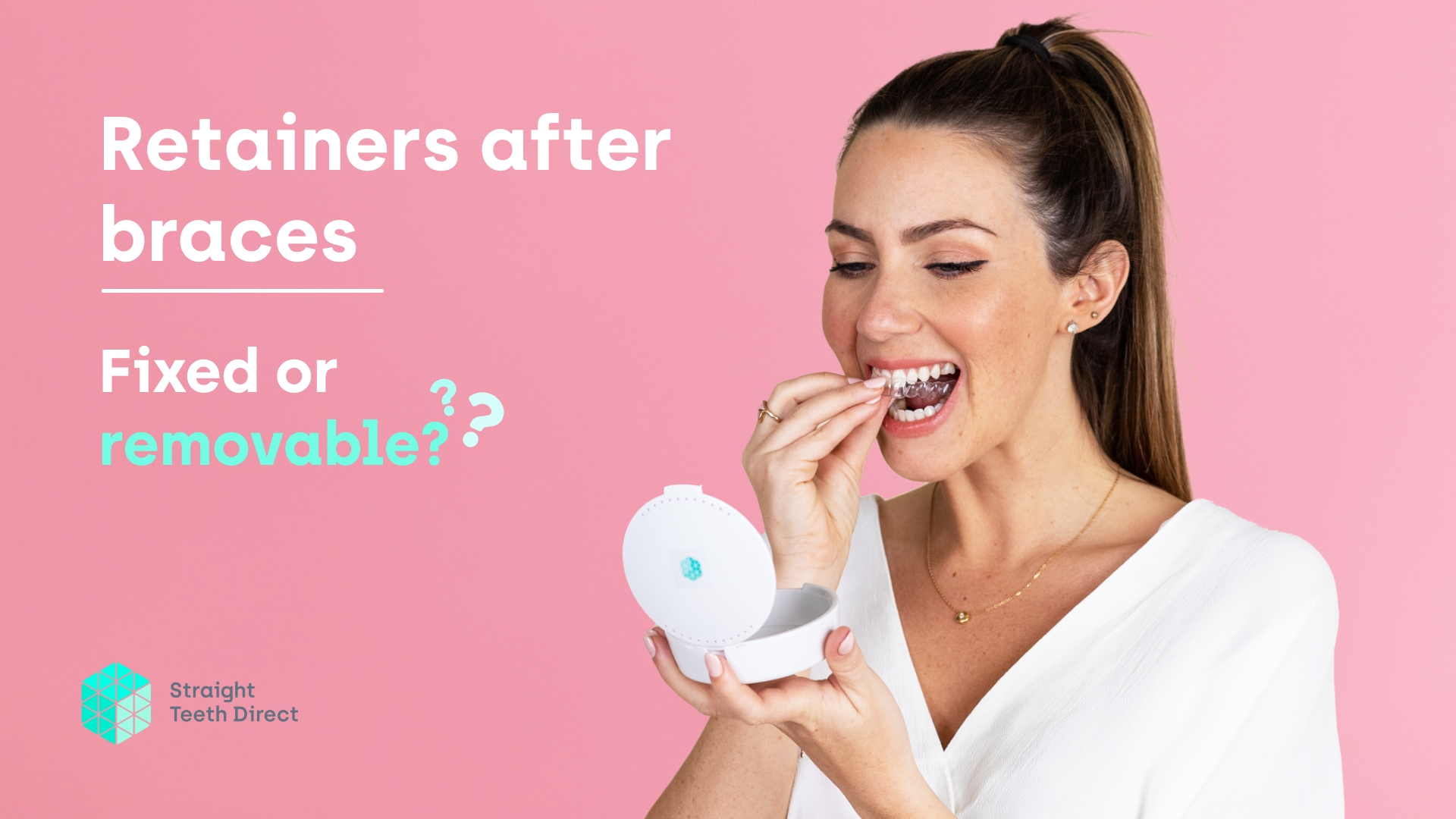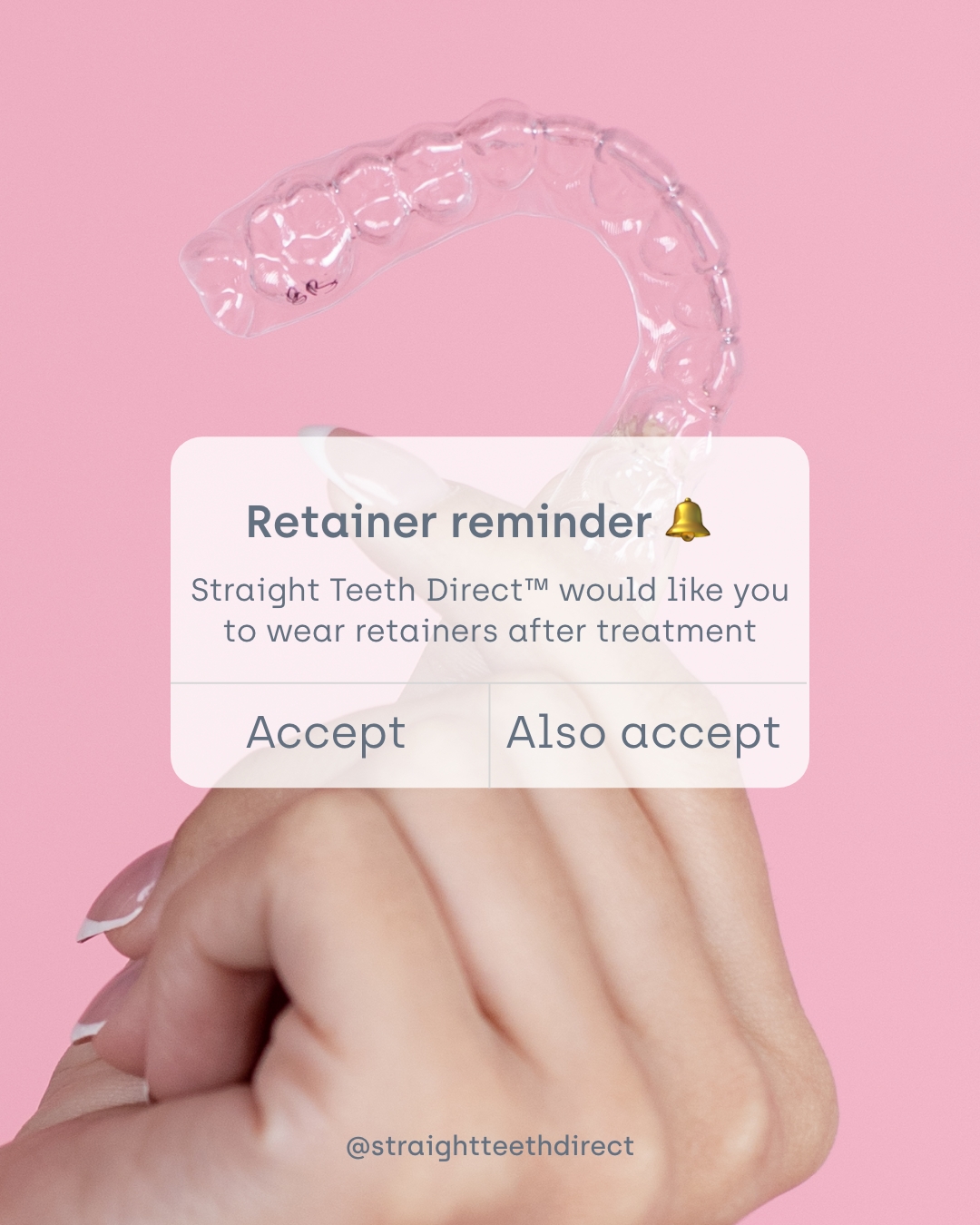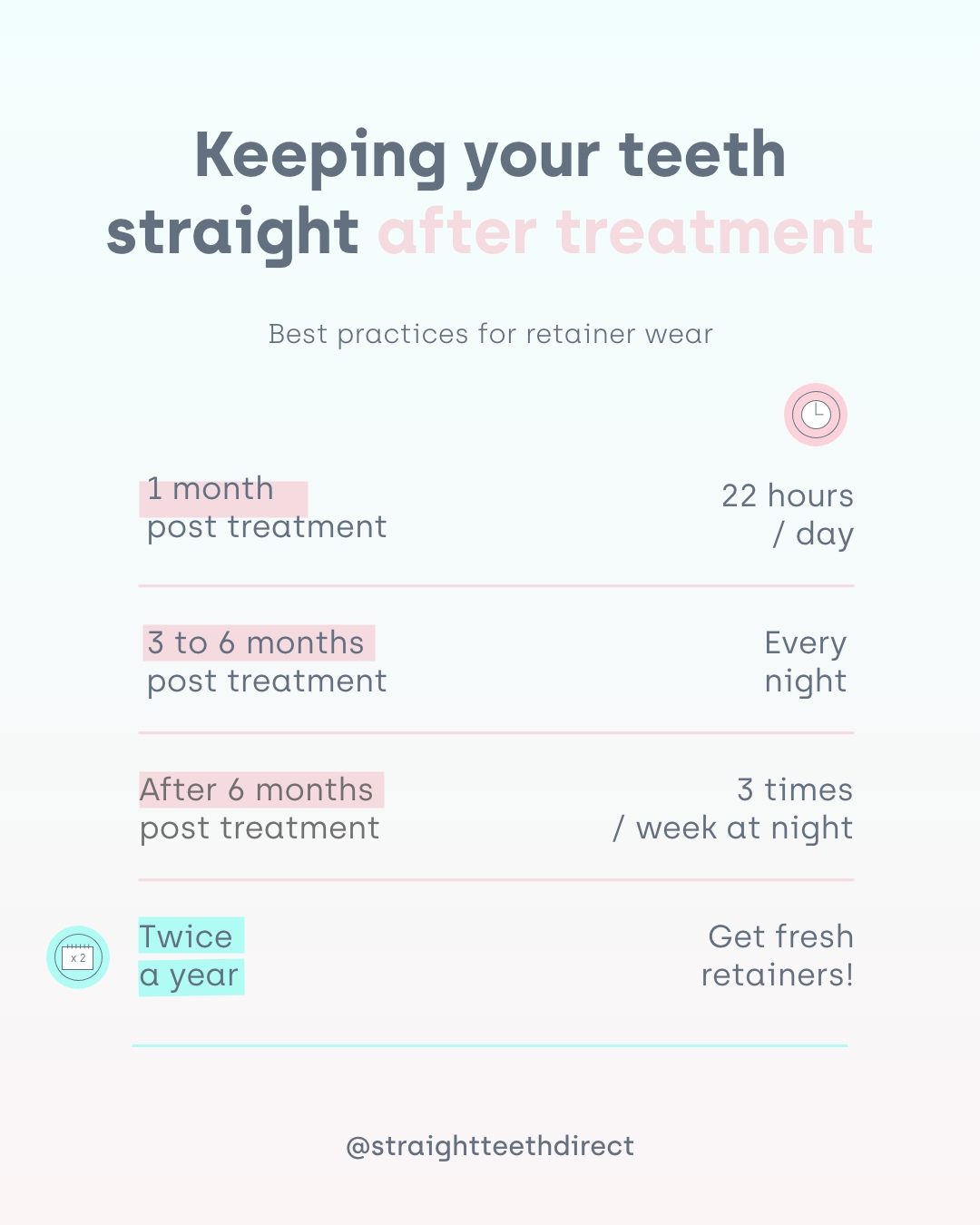
Retainers after braces: fixed or removable?

Key points:
- Without retainers after braces, there’s a high chance of your teeth shifting back and becoming crooked again.
- There are two main types of retainers for teeth: Fixed and removable. Which type of retainers should you wear after straightening your teeth?
- Retainers are meant to be used constantly for the first 2 to 4 weeks. After the first stage, you’ll be able to wear your retainers at night only for around 6 months. Finally, you should be able to maintain your teeth alignment using them 3 nights a week.
(Keep reading to get all the information you need about teeth retainers.)
Why you’ll need retainers
If you don’t want to find yourself googling something on the lines of “how to fix teeth after not wearing retainers?”…yes! You ALWAYS need to wear retainers after a teeth straightening treatment.

Teeth move in response to forces and there are constant, multidirectional unhelpful forces making your teeth crooked all the time. This is why your teeth get worse as you get older and shift after aligner or braces treatment.
Why will teeth always try to move without retainers?
Simple! Because of the main forces present in our mouth exerted by your:
- Cheeks;
- Jaw muscles;
- Tongue.
When your cheeks and jaw muscles contract, the outside of your upper teeth arch contracts too. Leaving your upper jaw more narrow – and V shaped – over time. That’s why your upper front teeth start to overlap, cross or stick out.
That means teeth can never fully set in position. It doesn’t matter how long you wear braces for, your teeth are always subject to move back.
Retainers finally recognised by the profession
After nearly 100 years of orthodontics, professionals are seeing people’s teeth becoming crooked again while adults. All this because they didn’t wear their retainers.
Some financial payment systems would only help paying for 1 year of retention. Meaning there was no aftercare, which is a reason why many people didn’t get followed up and are now looking into teeth braces options as adults.
Now you might wonder: Will a permanent retainer keep my teeth straight? And what are better: fixed or removable retainers?
So Fixed or Removable Retainers?
There are basically two main types of retainers: fixed retainers vs removable.
- Fixed retainers: made of a fixed wire bonded to the back of your upper or lower front 6 teeth – but sometimes only placed on the front 4 teeth;
- Removable retainers: made of a rigid BPA free plastic appliance that fits over your teeth. These can either be totally made of clear plastic or plastic and a metal wire.
You might wonder “Do I need a removable retainer if I have a permanent retainer?”. Even when using fixed retainers you still need a removable retainer if you had an orthodontic treatment that changed your arch shape. This type of treatment would have moved your premolars outwards, so you definitely need to hold them in place with a removable retainer. No fixed retainer will keep them there and that’s why it may be important to wear both permanent and removable retainers!
What are fixed retainers good for?
Fixed retainers are great to hold the front 6 teeth in place. If your dentist recommends them, it’s important that you know they need to be maintained. Be aware that if they break, it can go horribly wrong! Even if it only breaks slightly on one tooth, that tooth can move out of place.
If the retainers debond slightly, you can get food trapped in them. Fixed retainers are not the easiest to clean to start with…this can potentially cause severe dental issues if not looked after.
Either way, if you do need to get your teeth re-straightened at some point you would need new braces. No invisible aligners would fit over the fixed retainers on the back of your teeth.
So are fixed retainers a good alternative to clear retainers?
It’s only a good option if you maintain regular visits to your dentist and hygienist and commit to get it checked and repaired when needed. The mouth is a hostile place and we all like to eat crunchy foods.
In the paper Upper bonded retainers – Survival and Failure rates in the Angle Orthodontist Vol 81 No 6, a study on upper bonded (fixed) retainers was published based on 466 patients.
It showed shockingly that 58% of upper bonded retainers failed.
There are many studies showing the failure rate of fixed retainers thus we aren’t simply looking at lifetime retainers, we are also looking at lifetime maintenance too.
The ideal fixed retainers should…
- Be cleansable and flossable;
- Not interfere with biting / closing of mouth;
- Be thin & low profile so as to attract minimal plaque (not thick and bulky);
- Cover ideally 3-3 (canine to canine) as if only front two/four teeth covered more unwanted relapse occurs.
Are removable retainers better than fixed retainers?
Removable retainers are great and more hygienic as there is nothing permanently attached to your teeth and you can fully clean them and your teeth.
In fact the original Invisalign® system was designed when one of the founders tried to force fit his old retainer into place after his teeth had moved, and then thought of making a sequence of retainers. When we sleep, we can exert clenching and grinding forces through our back teeth. Forces strong enough to bite through bone, this means that plastic gets a beating, so over time it will flex and loosen. This is why your removable clear retainers need a replacement eventually.
In most cases, getting a new retainer involves new impressions of your teeth, a trip to the dentist, and manufacturing time. Sometimes this isn’t even ideal as teeth have only moved slightly and you only need a new retainer in exactly the same position as your teeth were. There are endless stories of people getting discouraged by new appointments and the cost of having new retainers made.
At this stage most people would’ve given up. And when this happens, they’d be giving up on their straight teeth.
How often do you need to wear your removable retainers?
In most cases, with clear retainers, you’ll be recommended to wear them day and night, for the first 2 to 4 weeks following your teeth straightening treatment. Only taking them out to eat and brush your teeth.
Is it OK to wear retainers only at night? After that first stage, you’ll be able to wear them at night only for the following 6 months or so and then 3 nights a week.

Keeping your retainers clean is essential. You will eventually notice they will start wearing down. But how long does a retainer last? We recommend you change them after 6/12 months depending if you grind your teeth at night and how you take care of them.
Teeth retainers cost: the different types of retainers
Now that you have no doubt that removable retainers are the way to go and you’ll need new sets from time to time, let’s address the elephant in the room: teeth retainers cost.
Fixed retainers cost
As a general rule, fixed retainers may cost somewhere between £100 and £400 – one arch only! If you need both upper and lower teeth retainers, the value will increase proportionally.
And then there are replacements needed…in most cases, a permanent retainer replacement can cost up to the same amount as the first one. Don’t forget that if you need a replacement, on average you will have to pay something between £50 and £150 to have the old one properly removed.
Even though fixed retainers are made to last, the higher prices may not be that beneficial if you think about the cons. It’s harder to clean your teeth, replacements are expensive and inevitable, and retainers do not even prevent molar teeth from moving back.
Clear retainers subscription: never pay for braces again
With Straight Teeth Direct clear retainers, you will get a system where new retainers are sent to you on subscription to give you the peace of mind you need. This is exactly what we offer as part of our Maintainer Plan.
For £179 a year extend your guarantee and receive two fresh sets of removable retainers every year, with the Basic Plan. Need something extra? Join the Premium Plan to receive 3 sets of retainers (6 individual retainers) and a 360 Whitening Kit every year for £399.
The beauty of this is that there can’t be catastrophic failure like with fixed retainers and if there is any relapse, your Maintainer Plan also covers your last 3 aligners, which can be sent out to restore your smile to alignment. This gives you the peace of mind and hassle free solution to keep your teeth straight for life.
Retainers for teeth FAQs
- What is the difference between braces and retainers?
In short, braces (like aligners) are used to move teeth, while all retainers are used to stop teeth from moving – usually after braces or aligner treatment. So, if you’re wondering “What comes first, braces or retainers?”, just remember that braces and aligners move your teeth into the straight position that your retainers then maintain.
- Will my teeth shift without retainers for 3 days?
The multidirectional forces in your mouth caused by muscles, tongue and lips are different from person to person. Some people may notice their teeth shift after one day of not using retainers, while other people may forget their retainers for even longer without a large difference.
The important thing to remember is this: without retainers, your teeth can (and will) always move to a certain extent. The only way to protect your smile for life is to consistently use a retainer according to your smile needs.
- Can I drink alcohol with retainers?
Just like with aligners, the only thing you should consume while wearing retainers is water. When it comes to alcohol or any other drinks, we suggest that you drink them without your clear retainers to avoid damage such as staining or breakage. Otherwise, alcohol and other sugary drinks will result in sugar getting trapped inside your retainers and in between your teeth, possibly leading to oral health issues like tooth decay or gum disease over time.
- Are fixed retainers permanent?
Permanent or fixed retainers are made of a metal wire that is bonded to your teeth using a tooth-coloured resin material. While they can last for years at a time, they are prone to snapping if you bite something too hard or floss too aggressively. In this case, it’s important that you visit a dentist to replace the retainer, as the now unbalanced pressure from the wire can actually cause your teeth to shift out of alignment.
Even if you never have any issues with them, they should be removed and replaced at some point, perhaps in combination with a dental hygiene appointment. The wires (similarly to fixed braces) can make it very difficult to properly clean between teeth, even using floss. This must be done professionally. Never attempt to pull out a fixed retainer yourself!
- What are essix retainers?
As we’ve discussed here, there are a few different types of retainers. Essix retainers are just one type of dental retention that protects the final results of your teeth straightening journey. In its essence, essix retainers are clear and removable plastic retainers, made to be worn after you finish your treatment.

Still thinking about it?
Fill in your email to receiveyour free guide!


















